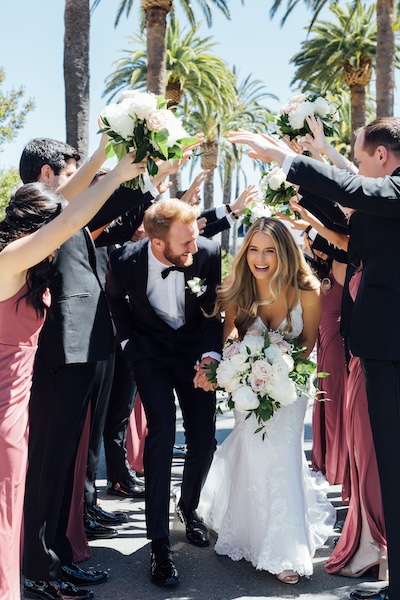Business + Marketing
What do wedding photographers want from online advertising? It’s usually pretty simple: a steady stream of clients who are having the kinds of weddings you want to shoot. But in a constantly evolving digital landscape, coming up with an effective, affordable ad strategy can get complicated. When we heard about San Diego-based wedding photographer Dan Hand’s success in doing just that, we asked him to break it down for us.
For the past few years, Hand has been running ads exclusively on Instagram and getting more inquiries than he can book. If you’re thinking he must be some kind of influencer who spends hours nursing his online presence, think again. “I’m one of those photographers that kind of hates social media,” he insists. “It’s so divisive, and I don’t like posting often because I start kind of judging my own clients based on how many likes they get. And I don’t like that.”

Hand started shooting weddings in 2012 and experimented with Google AdWords before shifting his focus to Facebook ads, but none of the approaches he tried brought him steady work in the Denver area where he was based at the time. “I was in a very competitive market, so my SEO wasn’t high enough and I didn’t have a lot of personal connections,” he says. “Even though my photos were great, I wasn’t really getting seen, so it was a struggle to book more than five weddings a year.”
On Facebook, Hand played with ways to boost and optimize his ads, but he still wasn’t getting results. “I would set a daily budget and it would get gobbled up immediately, and very rarely did I get any traction out of it,” he says.

Then one day, he checked the box for his ad to run on Instagram, which is owned by Facebook and share advertising tools. To his astonishment, Hand received 10 inquiries from potential clients within a couple days. “It was wild for me, you know, being social-media-inept and not posting a lot and not having a huge referral network. Getting 10 referrals in a weekend was just bananas. And they were all quality, and they all paid well.”
It wasn’t a fluke; the inquiries kept rolling in. “Every year, I’ve been able to get 20, 25, 30 weddings, and then an equal amount of engagement sessions out of it,” he says.

Eventually, Hand started unchecking the box for his ads to run on Facebook. “You can just turn everything off except for Instagram, which is what I do,” he says. He thinks a combination of distractions, easy ad-blocking and at least some of the public’s disenchantment with using Facebook at all leads viewers to be less responsive to his ads on that platform. “People go to Facebook for a lot of different reasons—to complain about politics, to look at friends and family, to do whatever it is that people do on Facebook,” Hand says. “On Instagram, you’re really there to look at photos first and foremost.”
It wasn’t just the platform change that made his ad successful. He had also carefully targeted it to appear in the Instagram feeds of a well-defined type of client. “She shops at Anthropologie and she probably drives a Subaru and she’s going to get married outside,” for instance, Hand says. Because he clicks best with clients who fit that description, he customizes his ad targeting for just that kind of person by selecting the relevant options in Facebook’s ad setup interface.

He starts by selecting people whose Facebook status indicates that they’re engaged. (“That’s half the work for you,” Hand notes.) Next, he refines his target audience by age, location and interests. “I’m 33 years old, and when I first started, I think I had my age range at women from 24 to 35 years old. Now I’ve expanded it to 24 to 40,” says Hand, whose clients are typically pushing 30.
After age, he selects interests. “I’ll probably put in 30 or 40 things,” he says. In addition to client favorites like Anthropologie and Subarus, he’ll add brands, local musicians and other cultural touchstones that are popular with the clients he wants to attract. “I target a lot of bands and things that I actually like,” he says, “and so when we do meet in person, we have a lot of things that we can personally connect over.”
One thing he strictly excludes from his ad targeting is anything related to photography. In fact, selecting wedding photography sites as target-audience interests is one of the biggest mistakes he sees other wedding photographers make. Their ads end up being served to their colleagues, many of whom, like Hand, are already married. “I still see a lot of people’s ads,” he says. “If I was getting married again—well, I’m a photographer. I probably already know who I’m going hire because I know a million photographers. So I’m a hard sell there. But I also am not getting married again. So, you know, it’s not the most effective use of your advertising budget.”
For the last three years, Hand’s expenditures for Instagram advertising have come to just over $1,000 and led to him booking nearly 100 weddings and about 60 engagement sessions. Although it’s difficult for him to calculate the value of his advertising precisely, he estimates that for every dollar he spends on advertising, he makes at least $150 to $200 back.

One of the reasons his outlay has been so modest is that he benefits from one of the idiosyncrasies of Instagram: People almost never click on his ad, but they start following him and contact him directly later. “If you set up your ad as pay-per-click and not pay-per-impression, you only get charged when they click the link on your ad,” he explains. To hold down the cost of clicks he does pay for, Hand targets areas in his region that are underserved by wedding photographers. Less competition means a lower price per click.
Of course, none of this would work if Hand didn’t have an eye-catching ad to run. When he puts it together, he includes a slideshow of images that he sets to go by quickly so that viewers see as many photos as possible while browsing Instagram. “The slideshow, I think, is what clinches it,” he says. “Other than being very specific in my targeting, I think showing seven to ten photos that are all good and show who I want to book—that’s where the true success comes from.”
Every shot he includes is selected to be aspirational for the kind of bride he wants to work with. “This bride who’s scrolling Instagram and sees my ad, she’s not going to stop on my ad until I give her a reason to,” he says. “So I want her to be like, ‘Oh man, that’s my wedding! That’s the wedding I want. That’s me in the photo.’”
When it comes down to it, Hand’s wildly successful ad strategy is about figuring out what kind of person you have good chemistry with, tracking them down, and then offering them the future they’ve always dreamed of. Sound familiar? As Hand says, “It’s a lot like dating, really.”
Related: How to Fill You Calendar with Dream Wedding Clients
How to Find a Balance with Social Media When You Own a Business
Video Marketing Tips to Drive Traffic Through Instagram Stories and IGTV
Focusing on Engagement Over “Vanity Numbers” on Instagram





